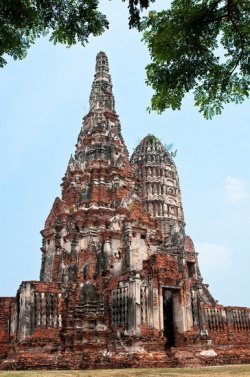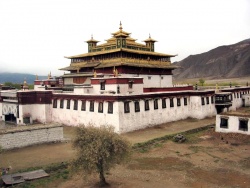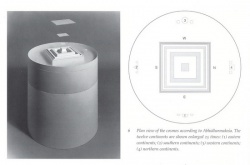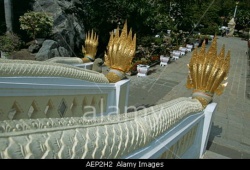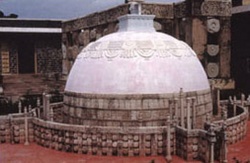Issues in Mādhyamika philosophy
Tibetan Buddhist thinkers, being generally adherents of some form of the Mādhyamika, had to provide answers to the question as to what was the correct and highest interpretation of Nāgārjuna’s thought and what were the erroneous interpretations and traps into which thinkers might fall when dealing with this difficult and often maddeningly ambiguous Indian philosopher (see Nāgārjuna).
Thus, for example, the Sa-skya-pa (Sagyaba) thinker Go ram pa bSod nams seng ge (Goramba Sönam sengge, 1429–89), in a text called lTa ba’i shan’byed (Differentiation of the Views), polemically described three types of Mādhyamika philosophy in Tibet: (
1) those which took the extreme of permanence to be the middle way;
(2) those which took the extreme of annihilation to be the middle way;
(3) the Mādhyamika free from extremes.
The first two views are those of mistaken interpreters, while the latter is supposedly Go ram pa’s own.
The dGe-lugs-pa (Gelukba) thinker ’Jam dbyangs bzhad pa (Jamyang shayba, 1648–1722), in his Grub mtha’ chen mo (Great Systems of Tenets), speaks of three sorts of erroneous view:
(1) the theory of the Chinese monk Hva-shang and certain bKa’-brgyud-pa (Gagyuba) philosophers that nothing exists (ci yang med);
(2) the voidness-of-what-is-other (gzhan stong) theory of the Jo-nang-pa (Jonangba);
(3) the view that the Mādhyamika does not accept means of valid cognition (pramāṇas), does not accept anything himself on either of the two levels of truth and does not have a system of his own (rang lugs).
To take the first view mentioned by Go ram pa (the second one mentioned by ’Jam dbyangs bzhad pa), much of Tibetan thought was indeed strongly influenced by an indigenous version of the Mādhyamika which attempted to integrate Nāgārjuna’s thought with Yogācāra and with the principal ideas in Indian texts such as the Ratnagotravibhāga (Differentiation of the Lineage of the Three Jewels), an early fifth-century text which notoriously speaks of a permanent (nitya), stable (dhruva) and eternal (śāśvata) Buddha-nature present in sentient beings.
This Tibetan synthesis was initially put forward by the Jo-nang-pa school, founded by Dol bu pa Shes rab rgyal mtshan (Dolbuba Shayrap gyeltsen, 1292–1361); for reasons that will become clear, the Jo-nang-pas and their successors came to be known as gZhan-stong-pas (Shendongbas), ‘those who accept voidness-of-what-is-other’.
The gZhan-stong-pa position had adherents in three of the four major traditions of Tibet – namely the Sa-skya, the bKa’-brgyud and the rNying-ma (Nyingma) traditions – and was championed by such major Tibetan thinkers as gSer mdog Paṇ chen Śākya mchog ldan (Serdok Paṇchen Shākya chokden, 1428–1507), Tāranātha (b. 1575) and many others (see Mi bskyod rdo rje);
in the nineteenth century, with the ‘rediscovery’ of the Jo-nang-pa texts, it became the philosophical underpinning of the ‘nonsectarian movement’ (ris med), founded by the syncretic thinker ’Jam mgon kong sprul (Jamgön gongtrul, 1813–99).
Only the dGe-lugs-pa school rejected it completely and unanimously, the Jo-nang-pas being for them a sort of bête noire both politically and philosophically, against which Tsong kha pa Blo bzang grags pa (Dzongkaba Losang dragba, 1357–1419) and his school repeatedly directed their ire.
The Jo-nang-pas and other gZhan-stong-pas relied on an adaptation of the Yogācāra theory of voidness that one finds in the Tattvārtha chapter of Asaṅga’s Bodhisattvabhūmi.
This they combined with the three-nature theory found in the Saṃdhinirmocanasūtra (Discourse on the Interpretation of the (Buddha’s) Thought; possibly second–fourth centuries ad), the theory that things have falsely imagined natures (parikalpitasvabhāva) invented by thought and language, causally dependent natures (paratantrasvabhāva) and an absolute or a perfected nature (pariniṣpannasvabhāva) (see Buddhism, Yogācāra school of).
The combination of Yogācāra with the Ratnagotravibhāga yields the key Tibetan distinction between ‘void-of-oneself’ (rang stong) and ‘void-of-what-is-other’ (gzhan stong) that has inspired enormous debates in Tibetan Mādhyamika up to the present day.
In brief, the fundamental gZhan-stong-pa ideas go like this for a Jo-nang-pa: the Absolute, pariniṣpannasvabhāva, whose existence enables us to avoid the nihilistic view that everything is just a complete illusion, is only void of the imagined and dependent natures: it is void of what is other than it, but is not void of itself.
The imagined and dependent natures, on the other hand, are nonexistent and are void of themselves.
This key stance is then fleshed out to include most of the other major currents in Indian Mādhyamika, Yogācāra, Tathāgatagarbha and even Tantric systems: for example, Nāgārjuna’s arguments in the Mūlamadhyamakakārikā show only that conventional truths (saṃvṛtisatya) are void of themselves; the Absolute is an existent, truly established gnosis (ye shes);
as in Yogācāra thought, this gnosis admits of no distinction between subject (grāhaka) and object (grāhya) and is suchness (tathatā) and the bhūtakoṭi (‘limit of the real’); it is identifiable with the Buddha-nature spoken of in the Ratnagotravibhāga; Tantric principles such as the union of voidness and bliss (bde stong zung ’jug) are said to be inexplicable without this version of voidness.
Not surprisingly, the Jo-nang-pas were often criticized, especially by the dGe-lugs-pas, but also by Sa-skya-pas such as Go ram pa, as reifying the Absolute and thus transforming Buddhism into a substantialist philosophy.
This is what was behind Go ram pa’s charge that this school ‘took the extreme of permanence as the Middle Way’.
(The Mongolian dGe-lugs-pa writer Thu’u bkwan Chos kyi nyi ma (Tugen Chögyi nyima, 1737–1802) went so far as to say that the Jo-nang-pas were in effect like partisans of a type of Brahmanism.)
The Jo-nang-pas thus supposedly went badly astray from Indian Mādhyamika by adopting positive descriptions which hypostasized a permanent Absolute, although, in all fairness, it has to be said that this criticism largely depends on which Indian texts one emphasizes and what literature one takes as authoritative.
It can be intelligently argued in defence of the Jo-nang-pas that there were Indian Mādhyamika texts, like the hymns attributed to Nāgārjuna, which did exhibit a positive, cataphatic approach not far from that of the Ratnagotravibhāga, and that Indian Mādhyamika did not consist exclusively in the negative apophatic dialectic or the insistence upon dependent origination (pratītyasamutpāda) that one finds in Nāgārjuna’s Mūlamadhyamakakārikā.
Subschools of Mādhyamika
Tsong kha pa and his followers, the dGa’-ldan-pa (Gandenba) and then the dGe-lugs-pa school, reject this all-encompassing syncretism, arguing that Yogācāra and Mādhyamika are quite distinct schools, and that Tantra and the Tathāgatagarbha theories are to be interpreted along the lines of Nāgārjuna,
and especially along the lines of the branch of Mādhyamika founded by Candrakīrti, the so-called *Prāsaṅgika or Thal-’gyur-ba (Talgyurwa) school.
Whereas the *Svātantrika or Rang-rgyud-pa (Ranggyuba) philosophy of Indian Mādhyamika, attributed by Tibetans to Śāntarakṣita, Bhāvaviveka et al., had been dominant in the earlier diffusion of Buddhism in Tibet (starting in the eighth century) and had been the philosophy of the first traditions in the beginning of the second diffusion (from the eleventh century on),
Tsong kha pa came squarely down on the side of the *Prāsaṅgika Mādhyamika, a school which owes much of its influence in Tibet to Pa tshab Nyi ma grags (Batsap Nyimadrak, b. 1054/55), who was the translator of Candrakīrti’s Madhyamakāvatāra (Introduction to the Middle Way) and other works.
Note that the terms *Prāsaṅgika (thal ’gyur ba) and *Svātantrika ([[rang rgyu] pa]]), although frequently used in the modern secondary literature, are not clearly attested in Indian texts.
This terminology to distinguish between Mādhyamika schools is Tibetan in origin and is especially found in a genre of literature which had great importance in Tibet, the hierarchical presentation of the ‘systems of tenets’ (siddhānta; grub mtha’) of the four Indian Buddhist schools and their various subschools.
There were numerous theories among Tibetans of the eleventh to fifteenth centuries about what the difference between *Svātantrika and *Prāsaṅgika actually came down to – indeed, the matter took on such importance that the question of how to construe the difference became one of the key issues in Tsong kha pa’s thought, just as it was a key issue for his predecessors and for many of his successors.
Some Tibetans had conceived of the difference between *Svātantrika and *Prāsaṅgika solely in terms of the logical forms which the two schools employed (namely, objectively valid reasons versus mere reductio ad absurdum); others focused on the fact that *Prāsaṅgika rejected means of valid cognition (pramāṇas) while *Svātantrika did not, or on the fact that *Prāsaṅgikas did not have any theses (pakṣa) whatsoever of their own, not even on conventional matters. (Compare ’Jam dbyangs bzhad pa’s third type of erroneous Mādhyamika.)
Reacting to the views of these opponents, Tsong kha pa formulated the difference as turning, above all, on a difference in ontology, in particular on the acceptance or rejection of things being in some way established with/through their own intrinsic natures (rang bzhin; svabhāva).
Svabhāva, a key notion that Nāgārjuna and his commentators argue against, figures throughout the Tibetan presentations of the systems of Buddhist schools in the grub mtha’ literature, but with each school adopting an ever subtler position on the question – it is only, according to Tsong kha pa, the *Prāsaṅgika branch of the Mādhyamika school which rejects it completely and unconditionally; the *Svātantrikas still hold on to a kind of rarefied version of svabhāva, albeit only on the level of conventional truth.
The basic argumentation for this attribution turns on the *Svātantrikas’ own construal of the Yogācāra three-nature theory.
The question as to precisely what a Mādhyamika denies became a major issue in Tibet.
A dominant trend in Tibetan Mādhyamika thought was that promulgated by Pa tshab’s disciple Zhang Thang sag pa (Shang tangsakba), Go ram pa bSod nams seng ge and others, a position which came to be known as ‘the Mādhyamika free from extremes’ (mtha’ bral dbu ma) and which was often depicted as ‘the view of neither being nor nonbeing’ (yod min med min gyi lta ba).
This view advocated using Mādhyamika-style arguments to show the incoherence of any and all things that one might analyse, with the result that no predication of being, nonbeing, both being and nonbeing, or neither being nor nonbeing is rationally justified.
We thus have, on this interpretation of the Mādhyamika, a literal and unqualified negation of all members of the ‘tetralemma’ (catuṣkoṭi), with the purpose of thoroughly overcoming the possibility of any conceptualizations and discursive thought.
This ‘Mādhyamika free from extremes’, it should be remarked, is a pretty fair characterization of the usual Indian position, and corresponds quite well to the way in which certain important Western authors would characterize Indian Mādhyamika.
(In this sense, S. Matsumoto (1990) is certainly right to stress just how remarkable and unique Tsong kha pa was in the history of Indo-Tibetan Mādhyamika in opposing the fundamental position of the ‘Mādhyamika free from extremes’.)
The question does, however, arise as to whether this version of the fourfold negation leads to a deviant logic, as negating nonbeing would seem to imply being, and negating the last lemma would seem to imply being or nonbeing.
Tsong kha pa and his school avoid these types of unwelcome consequences by adding the modal qualifiers ‘truly’ (bden par) and ‘conventionally’ (tha snyad du) to the tetralemma, so that, for example, the first two negations end up being that things are not truly existent and not conventionally nonexistent.
The tactic obviously avoids violations of logical laws.
Equally, it allows the Mādhyamikas to make a clear separation between the conventional and the ultimate, so that they can argue that a thing like a pot exists (conventionally) and is established by means of valid cognition.
We can thus easily hold the thesis that the pot exists, but where the Mādhyamika philosophy comes in is to show that it does not truly exist.
Indeed, the advocates of the ‘Mādhyamika free from extremes’, as well as the gZhan-stong-pas, do have serious problems in accounting for conventional truths: to say, for example, that such truths merely exist for mistaken minds (blo ’khrul ba’i ngor yod pa) and are not established by means of valid cognition (pramāṇas) comes perilously close to just falling into the trap of subjectivism, where one says that things exist or have such-and-such properties when one believes that they do.
(Quite a bit more than that is needed to explain how we can discover new things and how we can show that things which many people believe in at some particular time do not exist and have never existed even conventionally.)
The issue of the acceptance or rejection of pramāṇas establishing conventional truths is developed at length from the fifteenth century onwards, starting with a critique of Tsong kha pa on this and other points by the Sa-skya-pa thinker sTag tshang lōtsa ba (Daktsang lodzawa, b. 1405).
It should be stressed that the logical simplicity and lucidity of Tsong kha pa’s version of Mādhyamika comes at a high exegetical and philosophical price: not only is he constrained to add words everywhere to Indian texts, but, what is perhaps more serious, he can well be accused of inventing a factitious notion, ‘true existence’, which he then refutes as incoherent and contradictory, leaving the ordinary world intact and even reified.
This was a common criticism of Tsong kha pa.
Arguably, as his critics maintained (be they advocates of the ‘Mādhyamika free from extremes’ or gZhan-stong-pas), Nāgārjuna and his commentators were showing the utter incoherence of ordinary things themselves, and were leaving nothing whatsoever unassailed and intact among these conventional entities.
The role of conceptual understanding in spiritual realization
Tibetan thought on the nature of meditation and spiritual realization seems to be divided into two camps, both stemming (in very complex ways) from the Great Debate of bSam-yas (Samyay) in the latter part of the eighth century.
This debate was a (year-long?) series of exchanges which are reputed to have opposed the ‘Gradualist’ (rim gyis pa) Indian Buddhism represented by Kamalaśīla and others to the Chinese ‘Subitists/Simultaneists’ (cig car ba), who were represented by Hva-shang Mahāyāna, a monk from Dunhuang holding Chan positions.
The historical details of the Great Debate (which is with few exceptions depicted in Tibetan sources as having been won by the Gradualists) cannot be developed here, except to say that it now seems clear that several ‘heretical’ positions of Chinese, Tibetan and even Indian origin were under attack from the Kamalaśīla side.
In fact, as D. Seyfort Ruegg (1992) has insightfully remarked, the debate became a partly dehistoricized topos in the Tibetan representation of the history of their own philosophy.
The bSam-yas debate and its traces were perceived to recur constantly in the form of an opposition between two models of the Buddhist path, namely mediacy versus immediacy – the path taken as a progression, where philosophical analysis and various moral practices lead step by step to awakening versus the path which is not a series of intermediate steps, but is fundamentally identical with the fruit to be attained.
This latter ‘path’ is one where realization comes from a mode of awareness that is characterized by no mentation (amanasikāra; ci yang yid la mi byed pa), an awareness that consists in seeing or coming face to face (ngo ’phrod) with the nature of the mind (sems nyid) without reliance upon any concepts whatsoever – this realization is all we need to become enlightened at once.
To take an important example of the recurrence of this debate, the thirteenth century’s greatest thinker, Sa skya Paṇḍita (Sagya Paṇḍita, 1182–1251), makes a rapprochement between the Hva-shang side and the Tibetan tradition of Great Perfection (rdzogs chen) by criticizing the ‘Self-sufficient White Remedy’ (dkar po chig thub) doctrine of the bKa’-brgyud-pa scholars sGam-po-pa (Gamboba, 1079–1153) and Zhang-Tshal-pa (Shangtselba, 1123–93) as being a revival of the ‘Great Perfection of the Chinese tradition’ (rgya nag lugs kyi rdzogs chen).
(Compare ’Jam dbyangs bzhad pa’s first type of erroneous Mādhyamika.) Another example:
for Tsong kha pa, Hva-shang becomes an exponent of a mere blank-mindedness, a kind of stupefaction where one supposedly rests virtually unconscious.
This Hva-shang-style blank-mindedness is then taken to be what will ensue if, like certain ‘Mādhyamikas free from extremes’ who deny ‘too much’, one rejects all entities and all predication whatsoever and hence fails to make the proper distinction between so-called truly established things and conventional things.
What was the issue?
Did the Hva-shang position lead to nothing but voluntary stupefaction, as Tsong kha pa and even some contemporary Western writers depict it?
To use Ruegg’s phrase, the Great Debate involved ‘lattices’ of related ideas, and the lattice of ideas associated with the partly dehistoricized version of the Hva-shang position involves, very noticeably, the idea of an innate nature which is in some sense already perfect and actual.
Indeed, in a twelfth-century account of the Great Debate, the Chos ’byung me tog snying po, and in the sixteenth-century historical work the mKhas pa’i dga’ ston (Feast for Scholars;
Minzu chubanshe edition, 1986: 389; see also Ruegg 1992: 73, 86, note 164), one of the ways in which the issue is formulated is whether sentient beings are ‘Buddhas from the beginning’ (dang po nas sangs rgyas) – Hva-shang’s side supposedly advocated a kind of innate version of the Buddha-nature (tathāgatagarbha) existing fully ab initio, not just as a germ or potentiality for enlightenment, but as already accomplished.
(Compare, for example, the view found in the nine sorts of Great Perfection teachings described in an early work, the bSam gtan mig sgron (Lamp for the Eye of Meditative Absorption) of gNubs Sangs rgyas ye shes (Nup Sanggyay yayshay, tenth century):
‘The nature of the Buddha, sentient beings and their objects is to be without exception enlightened in the great state of the spontaneous dharmatā, which is without beginning nor end’ (1974: 320; see also Karmay 1988: 114).)
It is not surprising, if one holds that there is a type of innate perfected nature, that the path should consist essentially in stopping thought and seeing this nature. It is also probably not very surprising that focusing on good actions along the path should seem to Subitists such as Hva-shang and others a significant distraction.
Non-mentation would not be a stupefaction, where the mind is reduced to virtual insentience, but would be more like a re-cognition or ‘anagnosis’ (to use the phrase of Giuseppe Tucci (1980: 13)) of what was already there.
Kamalaśīla’s side and its later followers of course panned this Buddhahood ab initio as an utter absurdity. During the Debate, for example, Ye-shes dbang-po (Yayshay wangbo) supposedly argued: ‘
If you accede simultaneously [to enlightenment) then why are you still doing anything; if you are a buddha from the beginning (dang po nas rgyas), what then is wrong?’ (pa’i dga’ ston, 1986: 389).
And elsewhere on the same page in the mKhas pa’i dga’ ston, he is represented as criticizing the idea of ‘being enlightened without having done anything’ (ci yang ma byas par ’tshang rgya ba).
All this is a kind of Gradualist common sense, but it is also somewhat unimaginative, especially so in that a number of clear-headed Tibetan and Chan philosophers devoted a lot of deep thought to this difficult subject and seem to have been quite aware of the gross absurdities into which one should not fall.
Finally, it is hard to agree with Samten Karmay (1988: 87–8) that the Subitists and Gradualists both accepted an identical version of the ‘spiritual basis’ (gzhi), and that therefore the debate turned only on questions of method.
Karmay argues this because of ‘correspondences’ that he sees between various key terms on each side, although these correspondences are far from clear; even when the same word is used on the Gradualist and Subitist sides (for example, tathāgatagarbha), it is unlikely that the concept is being taken in altogether the same way. In short, the idea of some sort of innate perfected nature is a crucial issue in the Great Debate; we are not dealing just with methods.
Indeed, if there is only method involved, and no question of Buddhahood ab initio being re-cognized, the general Subitist position becomes an almost grotesquely unintelligent method, and the criticisms by Kamalaśīla, Tsong kha pa and others about meditation without analysis yielding a rather useless mental tabula rasa become difficult to avoid.
Epistemology, logic and philosophy of language
The major developments by Tibetans in this area are to be found in the interaction of two currents of interpretation of Dignāga and Dharmakīrti’s thought (see Dignāga; Dharmakīrti).
The first current has its origin largely in gSang-phu Ne’u-thog monastery (Sangpu Nay-utok, founded in 1073), in the works of rNgog lōtsa ba Blo ldan shes rab (Ngok lodzawa Loden shayrap, 1059–1109), Phya pa Chos kyi seng ge (Chaba Chögyi sengge, 1109–69) and their disciples.
Subsequently, Phya pa’s Tshad ma’i bsdus pa (Summaries of Epistemology and Logic) became the groundwork for the ‘Collected Topics’, or bsdus grwa (düra) literature, which furnished so much of the epistemology of the dGe-lugs school.
From what we can glean of Phya pa’s thought from other works in his tradition and the works of his adversaries – his own works have not survived – he combined a creative intellect with what was probably a quite lacunary knowledge of the main texts of the Indian Buddhist epistemological school:
the result is not unlike what we find in certain early Chinese Buddhists, namely numerous insightful interpretations and new ideas, and, at the same time, many notions which were no doubt invented and had no actual basis in Indian texts.
The gSang-phu positions were strongly criticized by Sa skya Paṇḍita, the Tibetan who probably came closest to faithfully representing the positions of later Indian epistemology and logic.
In his Rigs gter (The Treasure of Reasoning), we find a repeated trenchant critique of ‘Tibetans’ or ‘Tibetans who pride themselves on being logicians’ – polemical shorthand for the gSang-phu philosophers.
None the less, gSang-phu thought had a persistent appeal due to what must have been its extremely seductive appearance of subtlety and rigour – indeed, as D. Jackson (1987: 137–8) points out, Śākya mchog ldan reported that in his time, in the fifteenth century, people often felt that the ‘Summaries’ were subtle and proven correct, while the Rigs gter was ‘extremely rough’.
Central to the gSang-phu-ba versus Rigs-gter-ba debates was the problem of universals (see Universals, Indian theories of §3).
The gSang-phu side (including the dGe-lugs) maintained a type of realism where at least some universals were thought to be real entities (dngos po), while Sa skya Paṇḍita himself and many of his Rigs-gter-ba followers, such as Go ram pa and Śākya mchog ldan, argued for the more usual Dharmakīrtian apoha theory, maintaining the unreality of all universals, indeed of all objects of conceptual thought.
(The apoha theory of language is the Buddhist explanation of the unreality of all concepts, treating a concept of A as a mind-invented exclusion of non-A (see Nominalism, Buddhist doctrine of).)
Indian Buddhism’s philosophy of language was thus considerably reinterpreted by the Phya-pa school, especially by the dGe-lugs-pa.
The latter would find textual sources in later writers like Śaṅkaranandana, but while certain Indian Buddhists (for example, Dharmottara, Mokṣākaragupta and perhaps Śaṅkaranandana) were probably tending towards some form of realism on the question of universals, it is very difficult to see how the Tibetans’ rationale for realism had much, if anything, to do with the reasonings of these Indian Buddhists.
The Phya-pa school’s interpretation of the Dignāgan–Dharmakīrtian version of concepts-qua-exclusion (ldog pa; vyāvṛtti), which they also applied to universals, logical reasons and all other mind-invented constructs, was to say that ‘exclusion itself’ or ‘universal itself’ (spyi kho rang) is unreal, but not all exclusions, universals, and so on, are unreal.
The point probably partly turns on certain features of the Tibetan language which make this type of explanation possible.
This and closely related moves, which the dGe-lugs-pas would maintain to be at the heart of ‘the difficult point of the apoha theory’ (gzhan sel dka’ gnad), had already been criticized by Sa skya Paṇḍita himself and would be devastatingly attacked by Śākya mchog ldan.
There were also numerous Tibetan developments in epistemology which genuinely contributed to clarifying key Dignāga'n and Dharmakīrti'an issues: for example, the Tibetan debates on the theory of truth in Indian Buddhism, on the notion of nonperception (anupalabdhi), and on the use of scriptural arguments, and Tibetan positions on the question of how to interpret Dharmakīrti’s proofs of the Buddha’s authority.
We find gSang-phu-bas and Rigs-gter-bas offering (conflicting) explanations of Dignāga’s Hetucakra (The Wheel of Logical Reasons), in particular of the so-called ‘inconclusive reason which is too exclusive’ (asādhāraṇānaikāntikahetu), which is by far the most difficult fallacy to understand in Dignāga’s system of nine reasons.
We also find the gSang-phu traditions, including the dGe-lugs, accepting many of the key elements of Ratnākaraśānti’s idea of ‘intrinsic entailment’ (antarvyāpti) as presented in his Antarvyāptisamarthana (The Justification of Intrinsic Entailment), even though these same thinkers still did not go so far as to accept the Antarvyāptivāda position that examples are dispensable in argumentation, and are only used for dullards (rmongs pa).
There were actually very few Tibetans who considered themselves real Antarvyāptivādins, the major possible exception being the Sa-skya-pa thinker Nya dbon Kun dga’ dpal (Nyawön Güngapel, c.1300–80), who is said to have espoused this view in his now lost commentary on Dharmakīrti’s Pramāṇavārttika (Commentary on Valid Cognition).
The Phya-pa tradition, largely independently, developed a remarkably sophisticated type of debating logic, with consequences (thal ’gyur; prasaṅga) replacing the usual triply-characterized reasons (trirūpahetu) and inferences-for-others (parārthānumāna) of Indian Buddhist argumentation.
This logic, which one finds elaborately developed in bsdus grwa texts, has a unique type of quantification and employs variables.
The Dharmakīrtian idea of the general entailment (vyāpti, literally ‘pervasion’) between the reason and what is to be proved had presented enormous philosophical problems in Indian logic, as it was very difficult to say precisely how one was to establish or know for certain when there was vyāpti – vyāpti had to be assured by ascertaining a necessary connection (sambandha) between terms (see Inference, Indian theories of §§5–6).
In this debating logic, however, the epistemological questions as to how we know that there really is vyāpti, or that there can be no counterexamples, are of curiously minor importance; they are, in any case, separated from the purely logical matter of the truth conditions for a universally quantified statement, that is, absence of counterexamples.
This is a type of progress, freeing the logical and formal matters around vyāpti from the probably unsolvable epistemological issues which preoccupied the Indians. Interestingly enough, the Phya-pa school and its successors, in their classifications of various types of consequences as having twelve different types of vyāpti, went into considerable detail on the logical connections between statements in a way which was quite unknown in India.
Moreover, we see here and elsewhere a marked turn towards a formal perspective: saying, for example, that such-and-such a consequence-statement will satisfy a certain kind of vyāpti if it satisfies another kind is indeed an abstraction away from content to matters of form.
It is, however, difficult to argue that the rules and approach of this logic represent a propositional or term logic of the sort developed by Stoic or Aristotelian philosophers, although it is certainly not opposed to classical theorems.
Source
TILLEMANS, TOM J.F. (1998). Tibetan philosophy. In E. Craig (Ed.), Routledge Encyclopedia of Philosophy. London: Routledge. Retrieved January 23, 2013, from http://www.rep.routledge.com/article/F003SECT1


